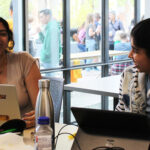
Engineering grad’s skills help set stage for growth of children’s care home
Posted: August 08, 2012
A private children’s residential care home in Mesa, Ariz., that has been serving its local community for almost 60 years will be better prepared to expand, thanks in part to the expertise of a recent Arizona State University engineering graduate.
During his final semester of study this past spring to earn a professional science master’s degree in the Solar Energy Engineering and Commercialization program, Sage Lopez helped the Sunshine Acres Children’s Home take steps to develop a cost-saving renewable-energy system.
To meet growing needs, the home plans to expand infrastructure on its 110-acre ranch – from 40 buildings and capacity to serve about 70 children to more than 65 buildings with capacity to house and care for as many as 250 youngsters. But rising electricity costs had been looming as a threat to the viability of such an extensive expansion.
Sunshine Acres Children’s Home is a Christian-based organization supported almost entirely by private donations and resale of donated items.
Sustainable energy source
Last spring, Lopez was working as an intern for TUV Rheinland Photovoltaic Testing Laboratory, a photovoltaic energy technology safety and performance testing lab that operates in partnership with ASU. His manager at TUV, Jonathan Belmont – who is pursuing a master’s degree in alternative energy at ASU – knew about the Sunshine Acres energy-system project. Belmont encouraged Lopez get involved.
Working with Milt Laflen, a member of a volunteer committee charged with ensuring the home’s future energy needs can be met, Lopez assisted in devising a solar-energy master plan designed to help control energy costs as Sunshine Acres grows.
He installed monitoring systems to provide real-time performance information for the power system.
He also worked with the facility’s power provider, the Salt River Project utility company, and with city of Mesa officials, to help clear the regulatory path for future installation of a “solar loop” that will efficiently distribute power throughout the site.
His work is helping Sunshine Acres get closer to its goals of having a “net-zero” energy system within 10 years. That means supplying all of the facility’s energy needs using only the electricity generated by its solar-power system.
Fulfilling endeavor
Among members of the home’s energy-system committee are Charles Backus, an ASU professor emeritus of engineering and provost emeritus of ASU’s Polytechnic Campus, and David Scheatzle, an ASU professor emeritus of architecture.
Backus says Lopez has made a valuable contribution to the electrical aspects of the energy-system design. Scheatzle explains that Lopez’s work “was meaningful in helping to clarify the layout and specifications of the current power infrastructure, and he proposed alternatives for developing a unique electrical distribution master plan that will incorporate extensive ground-mounted solar arrays.”
The project has been especially fulfilling “because of the respect everyone involved has for Sunshine Acres and the great work done there,” Lopez says.
“There’s been a lot of goodwill coming together to make progress. Sunshine Acres is becoming its own electricity-distribution center, all for the purpose of helping children,” he says.
An Arizona Department of Commerce grant provided for technology to produce 8.2 kilowatts of solar power for Sunshine Acres’ offices and eight solar water heaters. TUV Rheinland donated solar modules and Salt River Project donated a 10-kilowatt system through its Earthwise Project to provide power for a dining hall.
A 300-kilowatt system was installed through a lease agreement with the Green Choice Solar company, and photovoltaic panels providing 167-kilowatts have been donated by Solon, a solar technology manufacturing company.
Sunshine Acres plans to use its expanding green-energy system as an educational tool to teach children about energy engineering and technology, says executive director Sean Sloan.
Opportunity for more students
Lopez says the wide-ranging skill set he honed in his degree program armed him with the combination of managerial, financial, technical and entrepreneurial know-how necessary to take on the Sunshine Acres job.
His education has prepared him to work not only with fellow engineers but with business managers, professionals in building, construction and design industries, policy makers, utility regulators and social workers, among others, he says.
“There are opportunities for other ASU engineering students to get involved in the project,” Lopez says. “They can get experience applying their technical skills or just doing community service work. Either way, they can have a lasting positive impact on Sunshine Acres.”
Lopez is now using his education in an engineering job he landed in San Diego with Envision Solar. He’s designing next-generation technology – products called the Solar Tree Array and the Solar Tree Socket – for charging electric vehicles and electrical network metering.
Interest in solar studies increasing
The Solar Energy Engineering and Commercialization program, which offers a professional science master’s degree, is administered through the School for Engineering of Matter, Transport and Energy, one of ASU’s Ira A. Fulton Schools of Engineering.
It kicked off in the 2011 spring semester with the aid of a National Science Foundation grant. Five of the six students initially enrolled in the program have since earned degrees. Six more are graduating this summer. Eleven new students will begin studies in the 2012 fall semester, bringing current enrollment to 17.
This program enables students with undergraduate training in STEM subjects – science, technology, engineering and math – to expand their education across areas as such as energy engineering, project management, energy policy, utility regulation, professional ethics, and related fields.
The curriculum is guided by an industrial advisory board that helps to ensure courses provide knowledge and skills relevant to the solar-energy industry. Students benefit from an industry advisor in addition to a faculty advisor to guide their work on course projects in which they apply what they’re learning.
In partnership with ASU’s Consortium for Science and Policy Outcomes, students also participate in a week-long energy policy seminar held in Washington, D.C., to gain insight into energy policy making at national and international levels.
Written by Joe Kullman and Rosie Gochnour



































